Zarabianie na treściach i budowanie obserwujących to jedne z wielu rzeczy, o których marzy marketer treści. Ale co, jeśli Twoje filmy nie są tak przydatne, aby przyciągnąć uwagę? Czy obwiniałbyś swoje szczęście, czy zamiast tego włożyłbyś wysiłek w nauczenie się podstaw tworzenia filmów?
Jeśli chcesz wykorzystać podstawowe narzędzia do tworzenia filmów, jesteś we właściwym miejscu. Z tego artykułu dowiesz się, jak nakręcić film online nie tylko za darmo, ale także jak tworzyć filmy, które przemawiają do docelowych odbiorców, jakby siedzieli po drugiej stronie biurka.
Zacznijmy więc szybko.
Jak nagrać film online za darmo
Tworzenie wideo jest stosunkowo łatwe w Typito i może zająć tylko kilka minut.
Krok 1:Zarejestruj się i utwórz projekt wideo
- Wejdź na typito.com i załóż bezpłatne konto. Możesz zarejestrować się za pomocą swojego identyfikatora e-mail lub Google lub Facebook. Wybierz, co jest dla Ciebie wygodne.
- Po zarejestrowaniu zostaniesz przekierowany na stronę główną Typito. Kliknij Nowy projekt .
- Następnie zobaczysz listę formatów wideo. Kliknij format, w którym chcesz utworzyć film, naciskając utwórz przycisk.
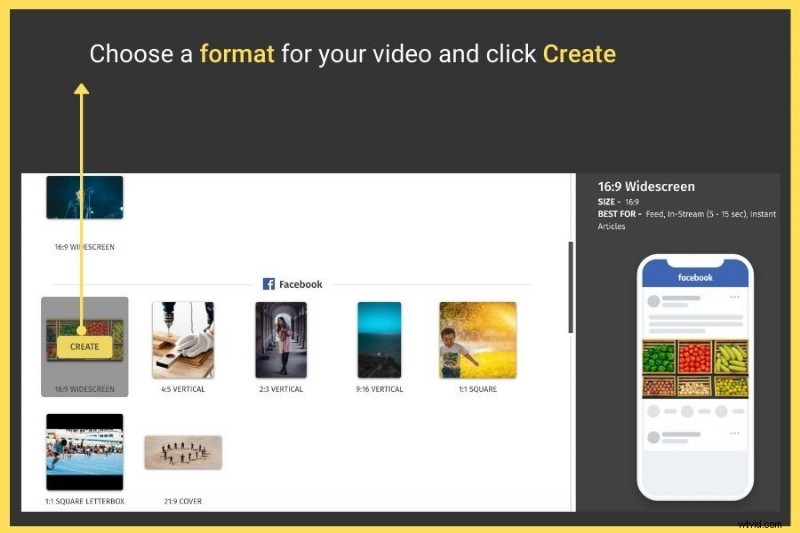
- Jeśli nie chcesz używać pokazanych wstępnie zdefiniowanych formatów i wolisz tworzyć własne, kliknij przycisk Utwórz format niestandardowy na górze.
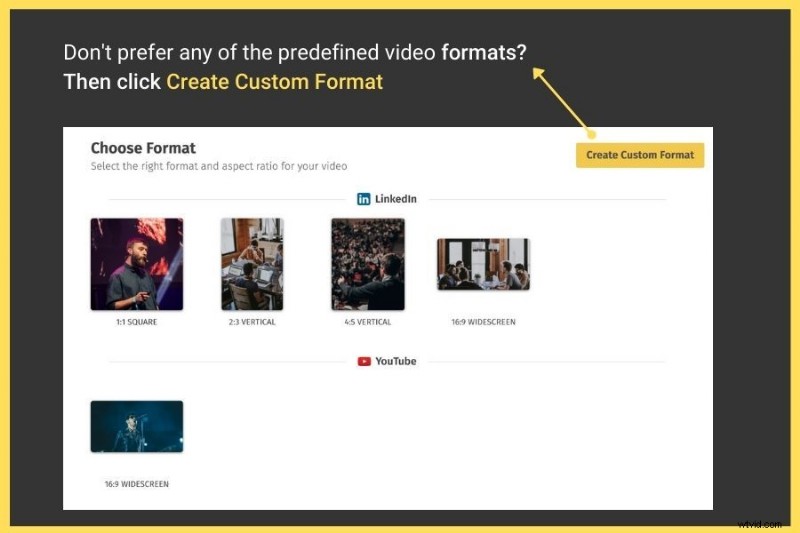
- Zobaczysz wyskakujące okienko, w którym możesz wprowadzić nazwę formatu wideo, przeznaczenie, szerokość i wysokość (w pikselach) oraz wypełnienie (w %). Po wprowadzeniu wszystkich szczegółów kliknij Utwórz .
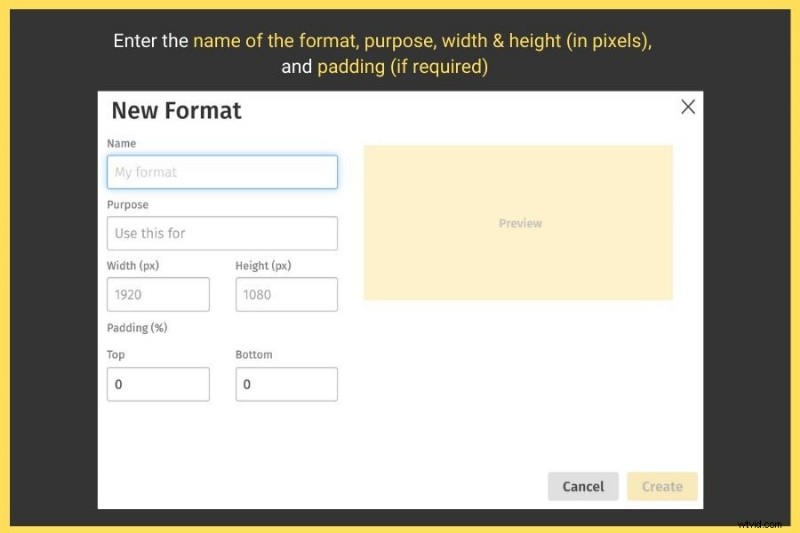
Krok 2:Prześlij film wideo ze swojego komputera lub wybierz z magazynu biblioteka multimediów
Bez względu na to, jaki format wideo wybierzesz (YouTube, Linkedin, Instagram, Twitter, Facebook lub Custom), zostaniesz przekierowany na stronę, która oferuje 2 opcje importowania wideo:
- Prześlij: Umożliwia przesłanie filmu z komputera
- Nośniki: Pozwala wybrać wideo ze zintegrowanej biblioteki materiałów filmowych
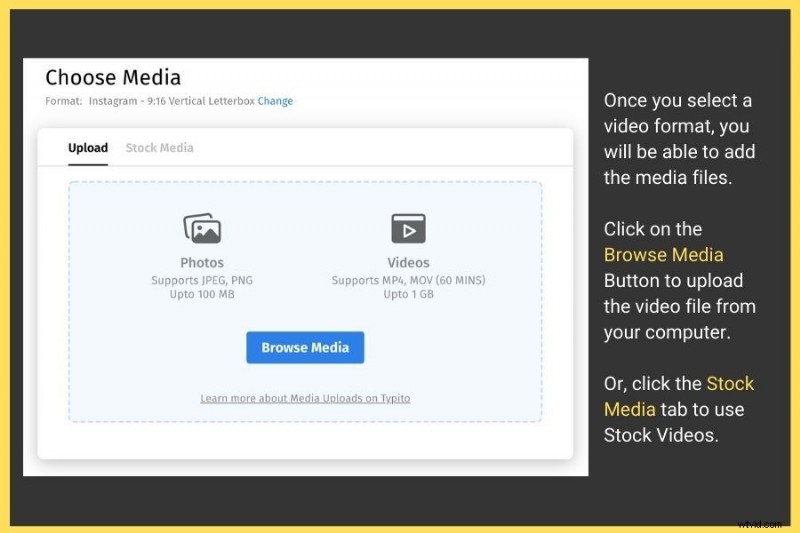
Wskazówka: Tutaj możesz zrobić dwie rzeczy:
- Utwórz film, używając tylko zdjęć i muzyki (zobacz tutaj)
- Lub prześlij nieprzetworzony materiał nagrany aparatem i nadaj mu profesjonalny wygląd, korzystając z wbudowanych funkcji Typito
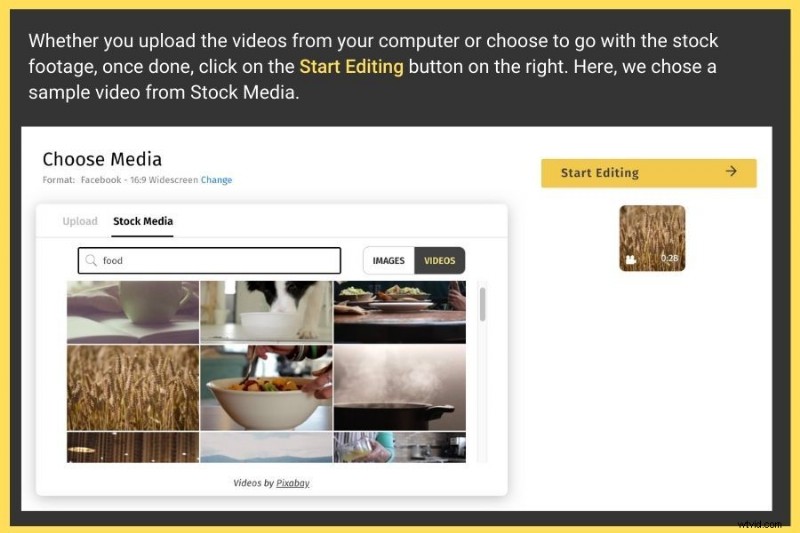
W zależności od rozmiaru przesłanego filmu proces importowania trwa od kilku sekund do minut. Po zakończeniu kliknij Rozpocznij edycję przycisk z prawej strony.
Krok 3:Edytuj film, aby nadać mu profesjonalny charakter
Zostaniesz przekierowany do przyjaznego dla użytkownika pulpitu nawigacyjnego Typito z przesłanym materiałem w tym samym formacie (lub wymiarach), który wybrałeś.
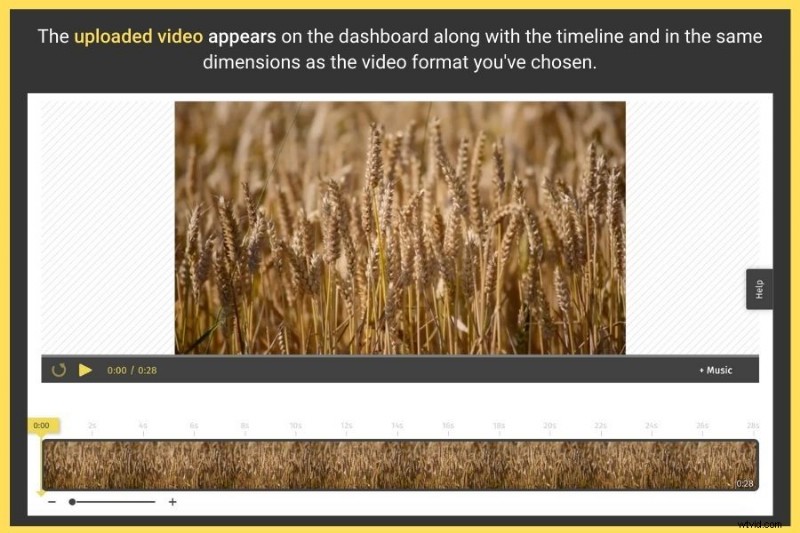
Zobaczysz 5 kart, które pozwolą Ci dodać niezbędne elementy do stworzenia wciągającego filmu w lewym panelu.
- Tekst w filmie — tytuły, dolne tercje i wezwanie do działania
- Nakładki obrazów
- Dodaj muzykę lub dźwięk
- Klipy wideo i graficzne
- Napisy lub napisy kodowane
Oto krótkie spojrzenie na to, jak każdy z tych elementów może ulepszyć Twój film.
1. Dodawanie tekstu do filmu
Dzięki tej opcji dodawanie tekstu do filmu jest dość proste. Oto, co musisz zrobić:
- W lewym panelu kliknij Tekst zakładka.
- Zobaczysz szereg wstępnie zaprojektowanych szablonów tekstu do wyboru. Jeśli jesteś nowicjuszem i prawdopodobnie nie wiesz, od czego zacząć, zalecamy wybranie jednego z tych stylizowanych szablonów tekstowych. Obejmują one zarówno podstawowe, jak i animowane szablony tekstowe.
- Aby zastosować szablon tekstowy do filmu, kliknij go raz.
- Gdy szablon tekstu pojawi się w obszarze roboczym wideo po prawej stronie, możesz go upiększyć, zmieniając styl czcionki, kolor, rozmiar, wyrównanie, odstępy między literami, wysokość linii itp. Poza tym możesz nawet dodać animację efekty w tekście.
Funkcja „tekst” obejmuje również kilka innych podkategorii, takich jak:
- Tytuły : Otwarcie filmu z dużym, pogrubionym tytułem tekstowym zapewnia świetne pierwsze wrażenie na Twoim filmie. Wybierz szablon pasujący do Twojego filmu z kolekcji szablonów tytułów.
- Media społecznościowe : Dodanie wezwania do działania w mediach społecznościowych to świetny sposób na zaprezentowanie obecności Twojej marki na wielu platformach. Możesz dodawać wezwania do działania, aby widzowie mogli Cię obserwować, w zależności od platform mediów społecznościowych, na których jesteś najbardziej aktywny.
- Dolne tercje : Rozważ dodanie podpisów tekstowych umieszczonych w dolnej połowie filmu, aby zaangażować użytkowników oglądających Twój film po wyciszeniu. Możesz wybierać spośród różnych animowanych szablonów tekstowych, aby nadać filmowi bardziej profesjonalny wygląd.
- Markowe : Jeśli masz logo swojej marki lub konkretne czcionki związane z Twoją marką, zdecydowanie powinieneś użyć tego w swoim filmie. Każdy z markowych szablonów ułatwia dodawanie logo do tytułów filmów.
Wystarczy raz kliknąć dowolny z tych szablonów tekstowych, aby dodać go do obszaru roboczego wideo po prawej stronie. Następnie możesz przeciągnąć i umieścić go w dowolnym miejscu.
2. Dodawanie obrazu do filmu
Może się zdarzyć, że będziesz musiał dodać kilka obrazów, kształtów lub ikon w środku klipu, aby uzyskać więcej kontekstu, lub po prostu nałożyć obraz swojego logo na swój film.
Oto jak łatwo dodać nakładkę obrazu, kształty lub ikony do swojego filmu:
- W lewym panelu kliknij Obrazy zakładka.
- Zobaczysz teraz 3 opcje:Kształty, Ikony, i Moje przesłane pliki .
- Kształty i ikony: Zawiera szereg wstępnie zdefiniowanych kształtów geometrycznych, których możesz użyć w swoim filmie.
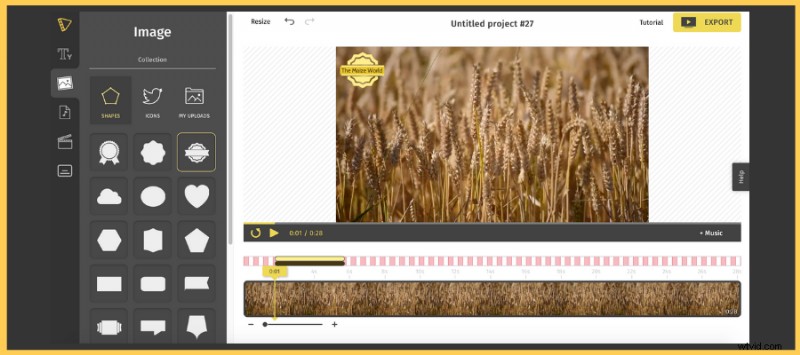
- Moje przesłane pliki: Dzięki temu możesz przesłać własne logo lub ikony, których chcesz użyć w swoim filmie.
Kliknij raz szablon, aby dodać go do swojego filmu po prawej stronie.
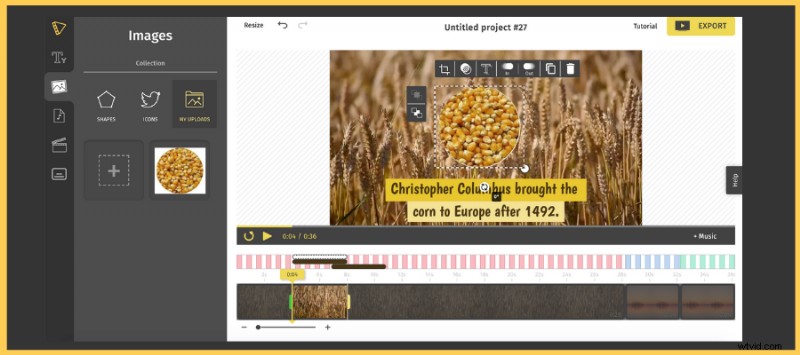
Muzyka odgrywa kluczową rolę w zwiększaniu zainteresowania Twoimi filmami. Jest to szczególnie ważne, jeśli tworzysz film bez tekstu, napisów lub urzekających elementów wizualnych.
3. Dodawanie dźwięku do filmu
Od stworzenia dobrego wstępu po dodawanie utworów w zależności od nastroju lub dostosowywanie głośności muzyki w tle — wszystko to możesz zrobić jednym kliknięciem.
Oto jak możesz dodać dźwięk do swojego filmu:
- W lewym panelu kliknij Audio zakładka.
- Zobaczysz dwie opcje:Biblioteka i Przesłane pliki .
- Biblioteka :Biblioteka audio zawiera ponad 150 bezpłatnych utworów, które możesz dodać do swojego filmu. Możesz przeglądać wiele gatunków/kategorii, takich jak - jedzenie, fitness, korporacyjne, przygodowe i nie tylko, aby wybrać ścieżkę muzyczną, aby znaleźć odpowiednią muzykę do swojego filmu.
- Najedź kursorem na utwór, kliknij przycisk odtwarzania, aby wyświetlić podgląd, a jeśli podoba Ci się to, co słyszysz, kliknij +Dodaj przycisk, aby dodać go do swojego filmu.
- Prześlij :jeśli chcesz przesłać własny utwór, po prostu kliknij przycisk Prześlij i wybierz plik audio z komputera.
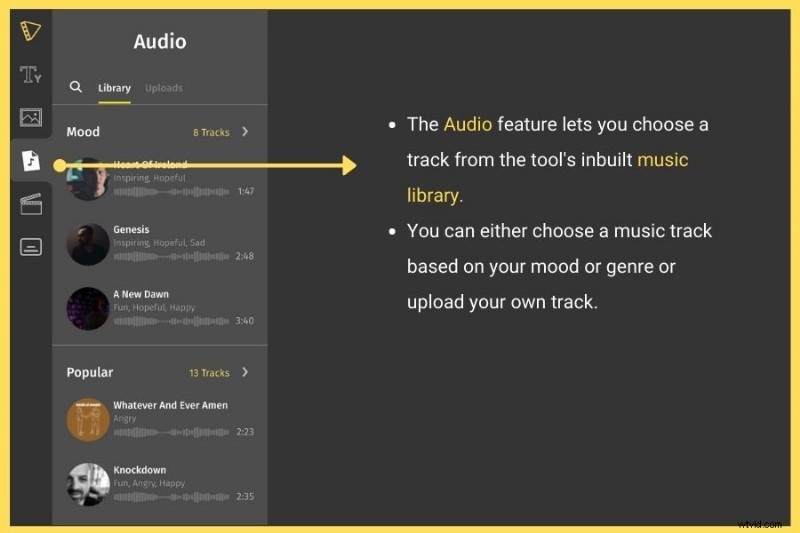
- Bez względu na to, jak dodasz muzykę, w momencie jej zastosowania natychmiast pojawi się wyskakujące okienko z opcją przycięcia dźwięku za pomocą przeciąganego suwaka. Dzięki temu możesz użyć określonej części dźwięku w filmie.
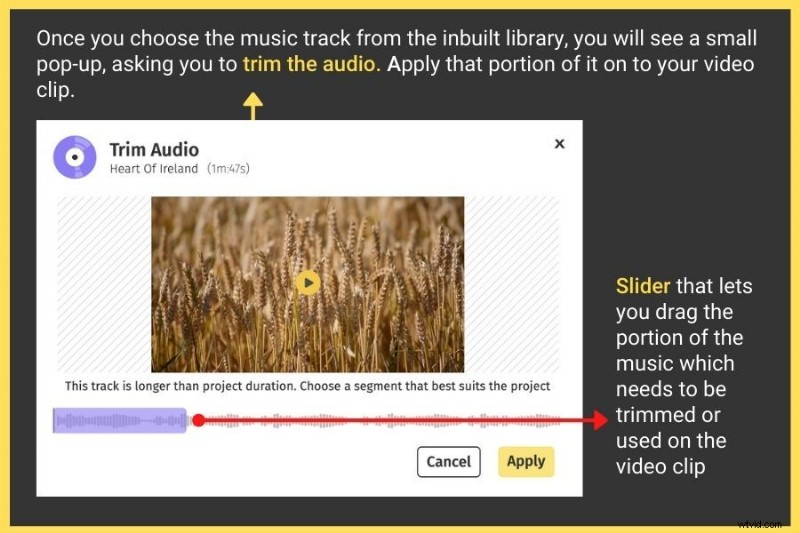
- Po dodaniu muzyki do filmu możesz w dowolnym momencie zmienić głośność zarówno tła, jak i muzyki.
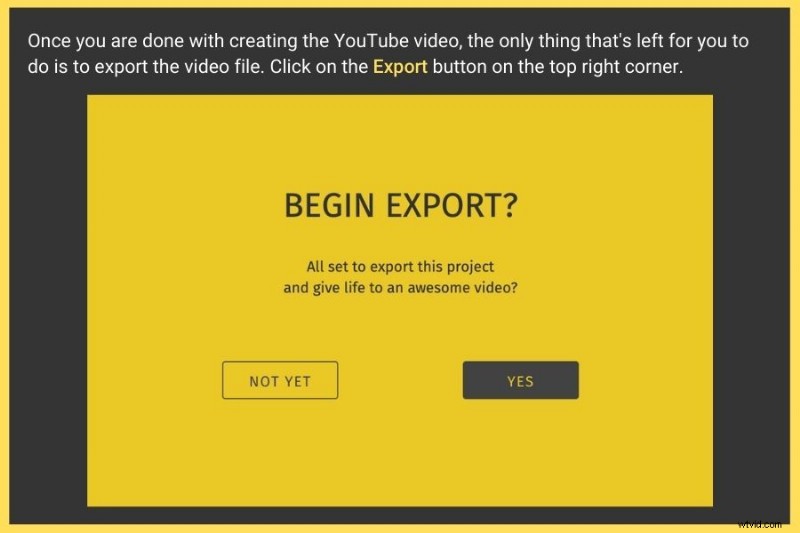
5. Dodawanie obrazów do filmu
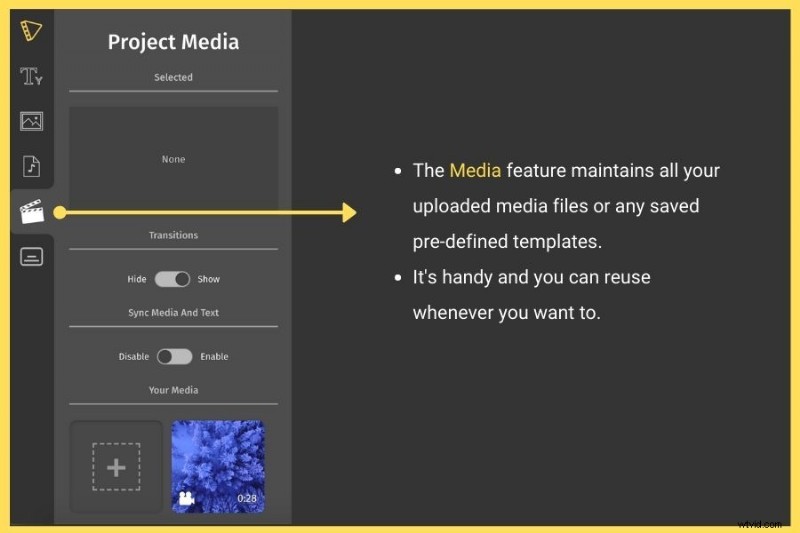
Media sekcja umożliwia przesyłanie obrazów lub większej liczby klipów wideo i łączenie ich razem w celu utworzenia filmu — na przykład pokazu slajdów lub klipów graficznych z efektami przejścia lub kompilacjami wideo.
6. Dodawanie napisów do filmu
Napisy to świetny sposób, aby Twoje filmy były bardziej przystępne i wciągające. Umożliwia osobom niedosłyszącym i niedosłyszącym nie tylko oglądanie treści wideo i korzystanie z nich, ale także ułatwia zapamiętywanie informacji. Co więcej, jest również świetny dla osób, które wolą oglądać filmy w środowiskach wrażliwych na dźwięk.
With Typito, adding captions is easy and straightforward. Here’s what you need to do:
- From the left panel, click on the Captions icon.
- You will see a wide array of basic and stylized text templates.
- Choose any one of the text templates that you like to add to your video and click once.
- This gives a preview of the way it looks on the video.
- You will also see something called Position , which is basically an option to align the captions to top, middle, or bottom .
- Once you’ve aligned the captions, the next step is to click the “Next, add content ” button.
- You will then be prompted to add the content for your captions.
Step 4:Export the video and download
After you have played around with all the features and perfected your video, you just have to download it. To do this, follow these steps:
- From the top right corner, click on the Export button.

- Your video begins to export. This takes from a few seconds to minutes, based on your video size.
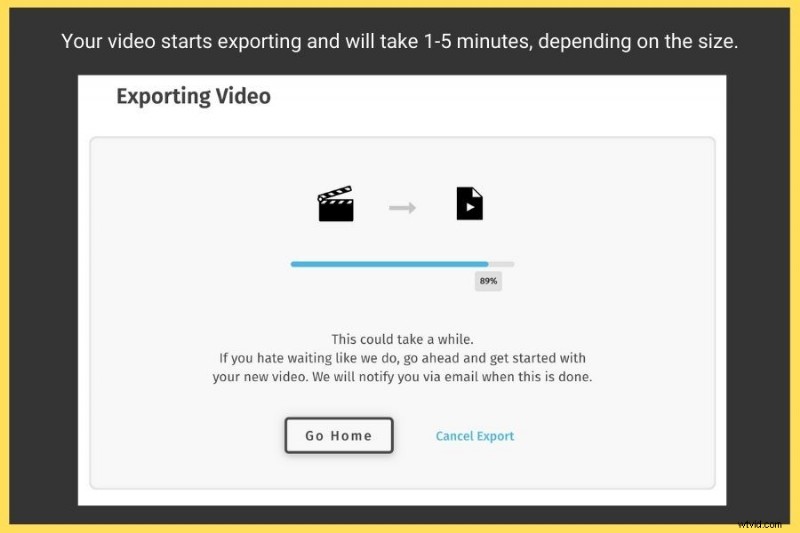
- Once that’s complete, your created video is ready to be:
- Downloaded in HD format and saved to your local drive
- Published to your YouTube channel directly
- Shared on Facebook

Now that you have learned how to make a video online for free, learn a few more essential video-making tips before you start making one.
Tips to Keep in Mind While Making a Video
If you’re nervous about making your first video, you aren’t alone. Most aspiring vloggers and videographers face the same hurdle after starting a YouTube channel or video project. Most of them can’t seem to understand how to make riveting video content with a modern vibe.
If you’re among the aspiring stars and cinematographers, here’s a chance you wouldn’t want to miss because in this blog you’ll learn the tips to keep in mind while making a video. So stick around till the end as we walk through the essentials that you’ll need even before getting started.
A lot of preparation goes into pre-production to get each shot right so that you don’t have to take the same path twice. My approach in this blog is to break down the process into smaller bits so that you can pause and practice each technique as you scroll.
Not to sound preachy, but you don’t have to spend a whole lot of money to become a professional video maker. At least, your first video needn’t be shot on a high-end camera, even a mobile phone makes a great tool to get the video professionally shot and edited with an easy-to use video editing tool like Typito.
Legends Make Videos and Not Clickbait
Congratulations on taking baby steps to launch your video project. The next stage is getting smaller things sorted. That includes brushing basics and keeping tools handy to start and finish the project within a stipulated time.
So without ado, let’s begin with tips that nobody talks about.
1. Light Brings Videos to Life
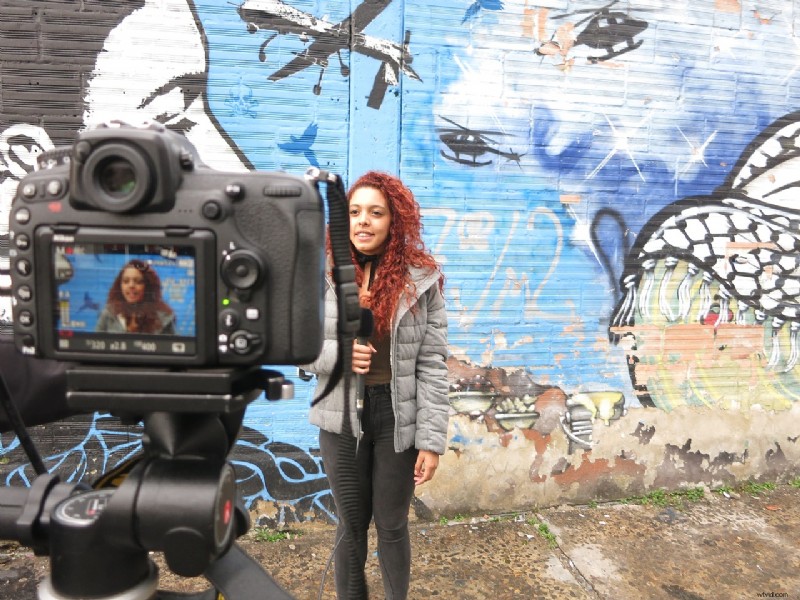
In cinematography, light shapes mood. It adds production value and makes the video richer and expressive. A soft light hitting the face brings the focus onto an object or character in your video while a bright dispersed light is more straightforward and general.
A misplaced light source clashes with the quality of the production and makes the video seem budget-strained. Natural light is strangely appealing in videos so shooting during the early hours and evening adds drama to scene composition.
At all costs, avoid shooting in piercing bright midday light to avoid dealing with unflattering shadows. It’s every video editor’s nightmare. While shooting indoors, experiment with symmetrical lights to illuminate the face and add intensity to the scene.
If you’re shooting marketing videos always leave the face well-lit for a positive vibe. If you’re taking the pro steps, it’s worth trying the lighting triangle to let the light flow around the features of your subject to create a pleasing composition.
2. Use Background to Compose Scenes

The background in a video is just as important as the foreground. If you are planning to compose a professional shot, choose the background wisely, and remove all distractions from the scene. Use a solid backdrop like heavy drapes and decorative paper to fill the void.
The most important thing is to make sure to place actors away from the backdrop to avoid inadvertent shadow casts. If you can’t make do with props available at home, rent a studio to use as a filming set.
When shooting at unfamiliar sets, be aware of reflective surfaces and window panes that reflect equipment or behind the scene crew. Moreover, placing actors near windows where outdoor light enters can cause unnecessary silhouettes.
3. Pick a Video Editor to Improve Quality

So you’ve got the production completed, what’s next? Raw footage is not a presentable material on its own. It must go through post-production where editors transform the footage by adding flavors like SFX, VFX, and also editing away unnecessary bits to arrive at a final version.
Even if you’re a beginner, make sure to use simple editing tools to make your footage appealing. These can take your video processing to whole new heights.
Some of the simpler features that you can exploit from free editing tools are text inclusion, cropping, scene transitions, and modifying aspect ratios. Some mid-tier versions also support filters, overlays, as well as stock audio and video.
4. Don’t Overdo the Edits

When you try the editor for the first time, be prepared to feel overwhelmed by its features. Only pick effects that increase the production quality and discard the rest.
In most scenarios, your footage may not need one or any effect at all. It’s always better to avoid going overboard with edits.
However, a few things are mandatory - Like using noise cancellation to remove background noise, adjusting brightness, cutting unwanted pauses, adding cool transitions, and BGM.
5. Use Audio to Make an Impact

Have you ever had to click a YouTube video and then immediately close it because of bad audio? It’s wired into humans to reject unappealing content, especially the audio.
Most people are patient enough to watch videos that may not be HD or if videos appear slightly grainy. But distorted audio is enough to make them pay no heed. So before making your first video, make sure you have set aside a small budget for an external microphone.
If you aren’t short-strapped, it won’t hurt to spend a little more on an HD microphone. After recording the audio from an outdoor location, edit away distractions like birds, wind noise, and traffic to call the viewer’s attention to a particular activity.
6. Use Image Stabilization

One important thing to remember in video-making is to record visuals without making viewers feel dizzy or seasick. Unless it’s part of the script, jerky videos will have people cursing you for not using a stable platform.
If you have shaky hands or aren’t set up to shoot hand-held, it’s best to set down the camera on an immovable surface (or use a gimbal or tripod if you have money to spare). Your skill will be put through paces when panning the camera. The smoother you do it, the more professional it seems.
However, if you can’t pan without ruining the production quality, consider changing perspective by cutting shots and making transitions.
If you still have shaky scenes in your master footage, use a video editing tool with image stabilization to fix the flaw. It’s mostly a one-click operation so it isn’t an exhausting effort. Alternatively, you could shoot using a video camera with built-in image stabilization.
7. Use Rule of Thirds to Compose Shots

If you insist on taking a professional approach, go with the rule of thirds to achieve pleasing footage.
According to this technique, the subject is placed along with the intersecting points on the grid lines. That is where the camera sensor captures the best details. It also adds a cinematic effect to the shot than having the subject stand in the dead center.
However, the rule of thirds isn’t always a textbook approach. It’s only a creative step to achieve unconventional results. If you’re a budding video maker, this is one of many important skills that’ll come in handy when regular shots start to seem unsuited.
8. Your Phone is a Great Video Making Tool

Thanks to Apple and its iPhone series, mobile photography exploded into a fad that people still follow. It’s a new genre where you don’t even have to own a DSLR to capture visuals. Instead, professional shots are conceived using just a mobile phone.
With manufacturers cramming more megapixels they can to phone sensors, it’s gotten better for end-users. Although not a replacement for pro SLRs, it does unarguably well compared to entry-level and mid-range SLRs. But be mindful of caveats if you’re going with mobile videography.
Shoot using the main camera because that’s where the sensor is bigger. Most selfie cameras on high-end mobile phones don’t fare as much as the main rear camera.
Shoot in the landscape to achieve the 35mm effect. It captures more details that improve video production quality on a larger screen. If possible use the overlay grid to maintain the level.
9. Create a Production Plan Before the Shoot

Above everything else, it’s important to meticulously prepare a plan beforehand to avoid last-minute changes. Impromptu shoots are great for a family occasion where moments weigh more than precision.
But if you’re stepping into the world of professional cinematography or if you want to make a career out of film-making, the complete schedule must be well-coordinated to avoid expenses from adding up due to disruptions.
Plan your production in stages and make sure to note progress, meeting deadlines, and time management. If you need a leg up in setting a basic production timeline, here’s what you need.
Start with production goals. Prepare questions like what you want to convey through your script and who will watch it and how your video will speak to viewers.
Whether shots will seem like a first-person/third-person perspective or a different one that isn’t tried before matters in production. You’ll be confronted with more questions as you get started and build momentum.
Once your goals are set, begin with scriptwriting and storyboarding. Most first-time video makers rush scriptwriting and stop abruptly when they’ve wandered off from the focus. It’s a learning experience, so don’t hesitate to revise portions till you’re satisfied with the way your script sounds when read out loud.
Here, being concise is the key to keep the audience riveted. Don’t prolong narrative portions unless it has any production value.
With the attention span of a goldfish, most content consumers would want excitement when the button is punched. They tend to become impatient when the plot slows down before getting to the interesting bits.
Podsumowanie
If making a video has been your life-long passion, get started now and use these tips to sharpen individual bits of production to make you make your video praise-worthy. I am sure, doing so will help you become a great filmmaker in the days ahead.
Most newbie filmmakers go through a vicious cycle of reworking their approach till it’s polished to perfection. Don’t forget to emulate the methods of rule-breakers because there is no single right path in video-making.
Modern video makers are constantly exploiting props and stage elements in bizarre ways to make shots shimmer. They do so, by deliberately deviating from traditions to get their work nominated for outstanding elements.
Someday, you could become an innovative filmmaker with a signature style that your movies will be associated with. So work persistently, and learn from mistakes to perfect your shots.
